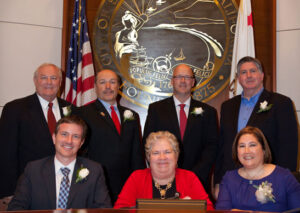
CITY HALL — Anyone who watched the June 25 City Council meeting or has since revisited either audio or video recordings of the event likely noticed something a little bit odd.
When it came time to vote, only six of the seven council members were on the dais to cast their yea or nay, but when Bob Holbrook's name was called by City Clerk Sarah Gorman, his disembodied voice piped up: "Bob Holbrook votes yes."
Holbrook sat in the mayor's office in City Hall watching the discussion play out on a computer screen in front of him, struggling to time his vote with the nearly 20-second delay between the streaming video and the action playing out in the council chambers with occasionally amusing results.
For reference, that room is all of 100 yards from the seats in which his colleagues discussed Santa Monica's budget for the next two years, a mix of cuts and enhancements that city officials hope will keep Santa Monica on the financial straight and narrow while they figure out what to do with looming deficits fueled by employee benefits and pensions.
Holbrook was recovering from knee surgery, and could not sit for long periods of time without elevating his leg. That meant it was either miss out on the budget vote or find another way to participate.
That's where the Brown Act came in.
The Brown Act, a 1953 law governing open meetings, was meant to keep the public's business in the public eye. It prevents elected officials from meeting secretly, or even communicating with each other in certain ways that might constitute an exchange of ideas on topics best presented in a public forum.
When the law first passed, the idea of a council member voting by phone was not top of mind — in fact, it was only included within the last decade despite the fact that the technology has existed far longer than that, said Kara Ueda, an attorney with Best Best & Krieger, which represents many public agencies.
"Law can't keep up with technology," Ueda said. "We can't write them fast enough to make it applicable to technology."
The Brown Act deals with teleconferencing in a fairly straightforward manner. The person participating by phone must publish the address of the place in which they intend to watch the meeting, post an agenda at that location in advance of the meeting and make it possible for the public to participate too.
In Holbrook's case, that meant people stopping by the room for a visit and a seat — the packed council chambers could no longer fit more people with questions or concerns about the city's finances.
Other meeting locations have been less accessible.
Mayor Pam O'Connor wears many hats, one as a member of the Southern California Association of Governments, or SCAG. The regional nature of the group, which includes 191 cities in the state, means that many members cannot be physically present at meetings.
For one meeting of the legislative committee, O'Connor was nowhere near southern California — she participated from a hotel room in Paris, France.
"We checked it out, there's no prohibition in the Brown Act that said you had to be on U.S. soil," O'Connor said.
O'Connor ran into the problem again during a key vote on a subway system for the Metropolitan Transportation Authority. The issue was scheduled for April 2012 but got pushed to May when O'Connor had plans to be in Hong Kong.
"If you look at the agenda, you will see where I was staying in Hong Kong," O'Connor said. "We posted (the agenda) in the hotel and no one showed up. It was midnight."
While the Brown Act was able to accommodate remote voting with little trouble, new technologies like social media, e-mail and texting all present challenges to the law and those who follow it.
The law dictates that a majority of elected officials cannot discuss issues pertaining to their offices unless they're at a public meeting, and specifically prohibits elaborate games of telephone or passing of messages that might confound that rule.
E-mail in particular can cause problems if people are not careful about the "reply all" function and end up with a "serial meeting" on their hands, a situation in which a majority of council members or other elected officialsbecome involved in a conversation that began between only a few members.
"Serial meetings can happen with speed and without premeditation or ill-intention," Ueda said.
Comments made on Facebook, Twitter, a blog post or even in the grocery store checkout line all fall into that category, which can make the proliferation of these kinds of technologies challenging, said Jay Fernow, an attorney with Fagen Friedman & Fulfrost, the law firm that works with the Santa Monica-Malibu Unified School District.
"We've told this to board members for years — be careful what you say because it could end up on the front page of the newspaper," Fernow said.
Texting has also become an issue. Some councils have a no-cell-phone policy so that they cannot even appear to be sending messages from the dais, be they about the policy matter at hand or what they want to have for dinner the next day.
Both Fernow and Ueda agreed that the Brown Act isn't likely to try to keep up with the multitude of ways in which communication can occur, and legislators probably wouldn't be successful if they tried.
In many cases, the question of "To tweet or not to tweet?" should be fairly self-explanatory under the law, Fernow said.
"At it's core, the Brown Act is that public business should be done in public," Fernow said. "There are a lot of common sense aspects to it. You can take the current language and the way the Brown Act has been interpreted by courts and apply current statutes to the practice of the board members."
ashley@www.smdp.com








